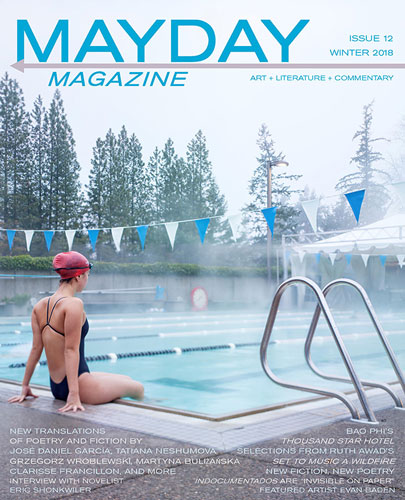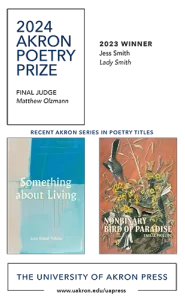MAYDAY magazine – Winter 2018
I started reading the latest issue of MAYDAY on May 1, of all days, so as I clicked through the poetry, prose, translations, and art in the Winter 2018 issue, my mind kept going back and forth between distress signals and a day of springtime celebration. While the pieces I gravitated to seemed to have more of that distressed feeling about them, one can also find moments of hope and celebration.
I started reading the latest issue of MAYDAY on May 1, of all days, so as I clicked through the poetry, prose, translations, and art in the Winter 2018 issue, my mind kept going back and forth between distress signals and a day of springtime celebration. While the pieces I gravitated to seemed to have more of that distressed feeling about them, one can also find moments of hope and celebration.
In “Changing,” Erinn Seifert patches together themes of loneliness and finding oneself. Cocooning herself in a quilt made of her grandfather’s old shirts, she comes to terms with the lack of feeling toward a boy who kisses her on the dock, “running his bony, calloused hands over your chest and down your ribs, plucking them one by one with his slim fingers, playing you like a guitar.” Instead she keeps thinking about the “blonde girl from [her] English class.” The quilt holds the piece together just as it held in Seifert as she changes, butterfly-like, into the person she’s meant to be: “rounder, more colorful, but still with ribs like strings waiting to be plucked.” A solemn and intimate little essay, Seifert gently wraps up on a note of hope.
The topic of being intimate is on Mollie Boutell’s narrator’s mind in the story “Intimates,” or, more accurately, the topic of underwear is on her mind. Narrator Nina finds an underwear catalogue in her boss’s office:
Not Victoria’s Secret or anything. It’s not some pathetic substitute available for men too embarrassed to buy Hustler or even Playboy. In fact, there are no models in this catalog at all—it’s just underwear. Men’s and women’s. Boxers and panties. No bodies; the bodies have been erased.
This sets off a day of self-examination and soul-searching, centered around appearance and undergarments. Nina compares herself to other women including her sister Beth and her coworker Sally, and she questions her worth versus her desirability to men, all with underwear as the backdrop that sets everything off.
Brian Kamsoke explores the idea of worth and purpose as well in his story “Useful Things.” Kamsoke’s narrator is preparing for the birth of his first child in the wake of being unexpectedly laid off from his plumbing apprenticeship, when the neighborhood is shaken by the discovery of their neighbor Jim who hanged himself in his barn. After Felix, another neighbor, discovers the body, the neighbors search for Jim’s two missing sons and wonder why he did the unthinkable. The narrator can’t help thinking about it in the scope of his own life: a baby on the way, no job, a wife depending on him. How desperate does one have to be to do what Jim did? He leaves off: “For now, she wanted to know what would make a man do what Jim did. I said I didn’t know, and I didn’t, except adding, ‘Sometimes, men think they have no alternative, and they’ll do the craziest thing.’” Seeing his inner thoughts, the decisions he’s making in the wake of this tragedy, we’re left with the belief or maybe the hope that the narrator won’t join Jim’s ranks.
My favorite poems this issue feature family. “Inside Out” by Matthew Guenette paints a picture of the speaker’s mother, focusing on her voice, that “could jerk you inside out like a shirt. / Then you’d be sorry / like when Steve stuck a snake in the fish tank,” even though “she was small and wore sweaters / like a cheerleader.” Guenette pinpoints the uncanny ability mothers have, always able to detect any wrongdoings you may be doing, his mother’s exploding voice all-reaching: “It could hear / you a thousand times in the graveyard /smashing bottles.” His mother’s voice is downright legendary, the speaker sure he even saw it one night. But he illustrates the other side of the coin, the worse side of his mother’s voice—silence: “the scariest part was the ride home, an hour’s / drive through a moonless dark, when she didn’t say a word.” Even though it has been years since I’ve taken that excruciatingly silent ride with my own mom, Guenette refreshes those feelings, breathing fresh, loud life into them.
“Inheritance” by Amy Sawyer paints an equally vivid image of the speaker’s uncle, his “morning beer kicked in early.” Images of alcohol continue, the kids “sloshed atop the vinyl seats” of his station wagon, “classy as koozies.” With this image, we’re not too surprised the group is up to something a little nefarious, their titular inheritance an ill-gotten gain:
Clip-on ties and wrinkled dresses
at the visitation, we fished cursed coins
out of the funeral home’s fountain.
Heirs to scrapping by, stealing luck.
From his casket, my grandpa made sure
that we are paying back every penny.
The poem is brief but colorful, like a quick chapter to a longer story I wanted to keep reading. I wanted to know more about the grandpa, the siblings, the disheveled uncle, and whatever they got into next.
The translation section shouldn’t keep readers wanting more, though. There is a hefty mix of translated poetry and prose to choose from, including two pieces by Martyna Buliżańska, the poems somehow beautiful in their images of loss and ruin.
Before navigating away from the issue, be sure to check out work by featured artist Evan Baden who offers a continuation of storytelling on his website with the photography series “The _____ High School Yearbook Project.” The series uses “their own stories, rumors, pop culture influences, and their own desires, we create images that belong to a world that appears to be real; and as far as truth in our society is considered, it is.”
Whether you find yourself feeling a little distressed or like celebrating, the Winter 2018 issue of MAYDAY offers work that covers both moods.
[http://www.maydaymagazine.com]






